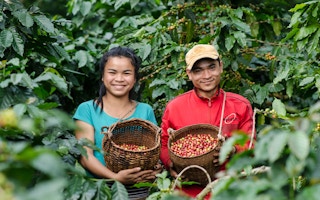With 500 million smallholders in the world producing agricultural crops that companies buy as raw materials, there is huge interest in finding effective strategies to include them in supply chains efficiently and profitably, for both the company and the smallholders.
To continue reading, subscribe to Eco‑Business.
There's something for everyone. We offer a range of subscription plans.
- Access our stories and receive our Insights Weekly newsletter with the free EB Member plan.
- Unlock unlimited access to our content and archive with EB Circle.
- Publish your content with EB Premium.
The Rainforest Alliance promotes responsible commodity supply chains that result in improved livelihoods for farmers and healthy ecosystems that sustain production over the long term.
Three main forces drive the commitment to responsible smallholder inclusion in supply chains. First being public commitments made by an increasing number of companies over the last two years to sustainable and particularly, deforestation-free supply chains.
The second driver is policy. A number of governments of countries where companies operate are passing legislation to support their rural populations that require companies that gain concessions to extract raw materials, to include smallholders in their operations.
The third driver is production efficiency.
Responding to these drivers for responsible smallholder inclusion, companies face a number of challenges. Efficient aggregation of smallholder volumes to reduce costs of transport and processing is one. A second is reliable quantity and quality of supply. Third, facilitating access of smallholders with services to upgrade their quantity and quality of output at a manageable cost is difficult.
Another difficulty is weak business management. Most small-scale farmers do not keep records of their costs or revenues. Social exclusion is a further difficulty, preventing services reaching all the people who contribute to the economy of a farm. Finally, on the smallholder side, legality of operations may be a problem. Smallholders may be under the radar of monitoring the permitted production areas.
There are also difficulties on the company side. Commercial pressures require companies to be cost competitive and as a result they have limited capacity to engage with the smallest and more remote producers or with producers that do not meet quantity or quality standards.
Rainforest Alliance collaborates with companies and smallholders to address these challenges. For example, in Sumatra, we have introduced the Nescafe Better Farming Practices together with Nestlé to 12,000 coffee farmers, by working with the trading intermediaries supplying them.
A similar model is operating in Sulawesi in cocoa, where we work with Olam. We are training its technicians in climate smart agriculture and farm record keeping and they are rolling that out through a system of trainers and lead farmers to 8,000 farmers who supply cocoa to them. The trainers include government extension workers, thereby bringing the government on board to the concepts and practices of sustainable farm management.
The Rainforest Alliance has drawn up five lessons for successful responsible inclusion of smallholders into company value chains.
- Integrating smallholders depends on mobilizing the intermediary companies in the supply chain and providing them with the knowledge and economic incentive. As a result, 1.2 million smallholders on 3 million hectares of tropical land are certified according to the Sustainable Agriculture Network (SAN) Standard.
In Central Sulawesi, where we work with Mars, Incorporated, we measured increases in the elimination of infected pods from the trees, which were causing up to 30 per cent crop loss, from 41 per cent of farmers to 95 per cent and in farm renovation from 0 per cent to 89 per cent of farmers surveyed, while the use of the dangerous herbicide, paraquat, reduced from 93 per cent to 16 per cent, replaced by integrated crop management. - It is vital to understand the context and not to make assumptions about smallholders’ interests. Rainforest Alliance’s work with Nestlé on its Rural Development Framework and a Lifescape & Landscapes Analysis undertaken in Sulawesi are examples of thorough analysis that enables understanding of the social and economic situation of smallholders and the political and environmental context that determines their use of natural resources, so that plans to include them in supply chains make the same sense for them as for the company.
- Develop the business case. Financial tools are essential to encourage investors to make financial services available to smallholders. The Rainforest Alliance published in 2016 analysis of the cost of three strategies for integrating smallholders more effectively into supply chains: the costs per hectare of implementing best management practices for improved quality and quantity; the costs per hectare over five years of renovating a farm through new seedlings and inputs; and the cost of establishing a small-scale mill for producing crude palm oil.
- Make training fun and inclusive. Use training materials that farmers can understand and a training methodology that keeps farmers engaged and entertained. Financial literacy training attracts women, as they usually manage household budgets.
Rainforest Alliance has found that women’s participation increases when women trainers are used and of course when training is scheduled at times that best fit around their domestic duties. - Use technology to simplify business systems and increase the flow of information. One of the main worries of commodity companies and brands is the lack of motivation for young people to continue farming. Training young men and women as lead farmers who are trained and then mobilized to share their learning with other farmers near to where they live has also been an effective strategy.
Building supply security and resilience with smallholders requires enabling their farms to be sufficiently productive and profitable and to look after the natural environment and the people who work on the farm properly so that they continue producing the commodity over the long term.
It also requires establishing supply arrangements that are commercially efficient and mutually respectful so that both sides see value in the relationship. Advances in technology and communications and the commitment to responsible sourcing offer a positive, enabling environment to increase the more direct and visible participation of smallholders in supply chains.
The degree of success will depend on the capacity of all parties to understand the barriers and design effective initiatives to reduce them.
Edward Millard is the Rainforest Alliance’s Director of Landscape & Livelihoods for Asia.











